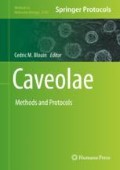Abstract
Biotin proximity labeling or BioID is a technique used to detect neighboring proteins, including transient and low-affinity interactions in their natural cellular environment. Here I describe the use of BioID in HeLa cells to identify proteins that can potentially interact with cavin1, one of the main components of caveolae. Briefly, the method consists in the transfection of the cells with the fusion constructs containing the promiscuous biotin ligase and cavin1 or control proteins, followed by biotin, cell lysis, affinity isolation of biotinylated proteins, biotin pull-down, and identification of the biotinylated proteins using mass spectrometry.
Access this chapter
Tax calculation will be finalised at checkout
Purchases are for personal use only
References
Cheng JPX, Nichols BJ (2016) Caveolae: one function or many? Trends Cell Biol 26:177–189
Parton R, Simons K (2007) The multiple faces of caveolae. Nat Rev Mol Cell Biol 8:185–194
Ludwig A, Howard G, Mendoza-Topaz C, Deerinck T, Mackey M, Sandin S, Ellisman MH, Nichols BJ (2013) Molecular composition and ultrastructure of the caveolar coat complex. PLoS Biol 11:e1001640
Kovtun O, Tillu VA, Ariotti N, Parton RG, Collins BM (2015) Cavin family proteins and the assembly of caveolae. J Cell Sci 128:1269–1278
Hayer A, Stoeber M, Bissig C, Helenius A (2009) Biogenesis of caveolae: stepwise assembly of large caveolin and cavin complexes. Traffic 11:361–382
Collins BM, Davis MJ, Hancock JF, Parton RG (2012) Structure-based reassessment of the caveolin signaling model: do caveolae regulate signaling through caveolin-protein interactions? Dev. Cell 23:11–20
Roux KJ, Kim DI, Raida M, Burke B (2012) A promiscuous biotin ligase fusion protein identifies proximal and interacting proteins in mammalian cells. J Cell Biol 196:801–810
Mendoza-Topaz C, Yeow I, Riento K, Nichols BJ (2018) BioID identifies proteins involved in the cell biology of caveolae. PLoS One 13:e0209856
Branon TC, Bosch JA, Sanchez AD, Udeshi ND, Svinkina T, Carr SA, Feldman JL, Perrimon N, Ting AY (2018) Efficient proximity labeling in living cells and organisms with TurboID. Nat Biotechnol 36:880–887
Shin JJH, Gillingham AK, Begum F, Chadwick J, Munro S (2017) TBC1D23 is a bridging factor for endosomal vesicle capture by golgins at the trans-Golgi. Nat Cell Biol 19:1424–1432
Sowa ME, Bennett EJ, Gygi SP, Harper JW (2009) Defining the human deubiquitinating enzyme interaction landscape. Cell 138:389–403
Nagaraj N, Wisniewski JR, Geiger T, Cox J, Kircher M, Kelso J, Pääbo S, Manna M (2011) Deep proteome and transcriptome mapping of a human cancer cell line. Mol Syst Biol 7:548
Author information
Authors and Affiliations
Corresponding author
Editor information
Editors and Affiliations
Rights and permissions
Copyright information
© 2020 Springer Science+Business Media, LLC, part of Springer Nature
About this protocol
Cite this protocol
Mendoza-Topaz, C. (2020). Biotin Proximity Labeling to Identify Protein–Protein Interactions for Cavin1. In: Blouin, C. (eds) Caveolae. Methods in Molecular Biology, vol 2169. Humana, New York, NY. https://doi.org/10.1007/978-1-0716-0732-9_9
Download citation
DOI: https://doi.org/10.1007/978-1-0716-0732-9_9
Published:
Publisher Name: Humana, New York, NY
Print ISBN: 978-1-0716-0731-2
Online ISBN: 978-1-0716-0732-9
eBook Packages: Springer Protocols

